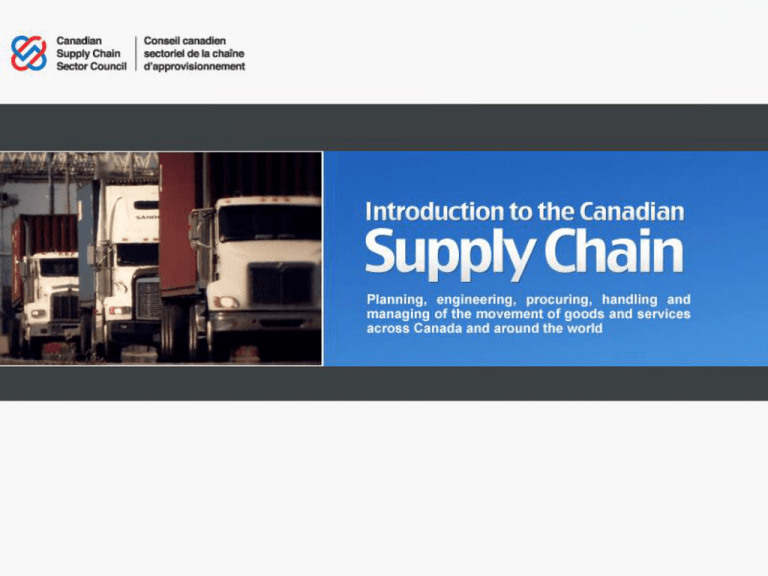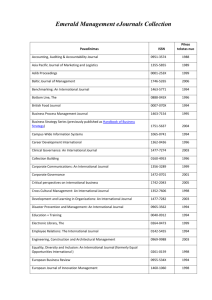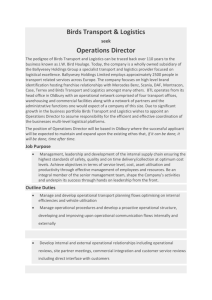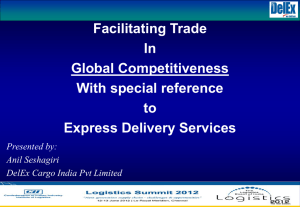What is the Supply Chain?
advertisement

What is the Supply Chain? • • Canada’s supply chain is the planning, procuring, handling, managing, engineering and enabling of the movement of goods and services across Canada and around the world Supply chain management encompasses the planning and management of all activities involved in sourcing and procurement, conversion, and all logistics management activities. This also includes coordination and collaboration with channel partners including suppliers, intermediaries, third-party service providers, and customers What is the Impact of the Supply Chain? • In 2007, Canadian goods exports amounted to $450.3 billion while Canadian goods imports totalled $406.7 billion. • 86% of Canada's merchandise exports are destined to the United States and approximately US $475 billion of goods cross each year between the two countries • SC activities include all manufacturers, wholesalers and retailers representing 29 percent of total Canadian GDP • The industry generates $50 billion revenues and $75 billion in additional activity is done in-house across sectors. • Most Best-in-Class (BiC)* businesses leverage supply chain to increase distribution efficiency and service differentiation while reducing distribution cost Why is Supply Chain Important? • Enterprises that deploy supply chain integration and supplier relationship management technology have seen a 15% to 40% increase in quality and time-to-market over competitors that fail to make these investments • The extent to which firms are integrated into global value chains and the efficiency and effectiveness of their product distribution and associated services are key determinants of competitiveness. Incremental competitiveness advantage is now achieved when supply chain players are synchronized Why is Supply Chain Important? (2) • Supply Chain Management is now becoming a key industrial sector as well as an enabler for innovation, competitiveness and commercialization of technology and processes across all industrial sectors • There has been a 60% growth in investment in new distribution facilities in Canada since 2001. • Within Supply Chain, logistics service providers GDP is expected to increase by 40% between 2007 and 2015, reaching 56 billion CAD What is the Canadian Supply Chain Sector Council? • CSCSC delivers a range of products and services designed to enhance excellence in the chain’s ability to recruit, retain, and train • One of 30+ organizations that are part of the HRSDC-funded Sector Council program • Different from trade and professional associations, the Council’s primary focus is on increasing capacity and competence of the human resources of the supply chain sector Who Are The People of Canada’s Supply Chain? Over 744,000 employees in seven sub-sectors: • • • • • • • Logistics Management Logistics Information Systems Warehousing Transportation Inventory and Material Control Purchasing Marketing and sales What are the Occupations of Supply Chain? Literally hundreds of jobs and careers in Supply Chain in managerial, tactical, and operational areas, including: •Operational: Storekeepers, parts clerks, long shore workers, shippers and receivers, drivers and equipment operators, material handlers, packagers, •Tactical: Manufacturing and industrial engineering technologists/technicians, database analysts, web developers, transportation route and crew schedulers, brokers, dispatchers, purchasing agents/officers, buyers in retail and wholesale •Managerial: Supervisors and managers of teams and organizations in a wide variety of applications, from operations of facilities to supervision of systems in all seven sub-sectors What’s in Supply Chain’s Future? • The high cost of energy will be a key driver for implementing Green Supply Chain Management practices, including multi-modal transportation, energy/waste reduction, reduced packaging • More and more highly advanced processes and technologies — both at the corporate level and within their distribution centres and transportation operations • Internet-based systems facilitate inventory management and organize delivery to customers and from suppliers What’s in Supply Chain’s Future? (2) • Advanced technologies, e.g. item-level traceability and supply chain visibility which will allow fast response to governmental requirements like anti-terrorism acts and food and drug regulations, product recall and public safety • Increased focus on reverse logistics (disposal or recycling at product end of life) • Need for flexibility: unplanned events (like the Iceland volcanic eruption) will have a significant impact on the Supply Chain, challenging SC managers to find creative solutions. Other examples include political/economic change in global trading patterns, currency fluctuations, continued increases in fuel prices, increased demand for lightened carbon footprint, and trade legislation











